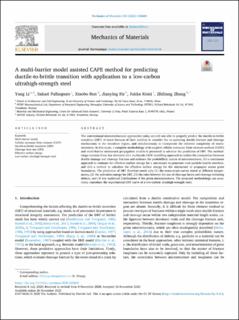| dc.contributor.author | Li, Yang | |
| dc.contributor.author | Pallaspuro, Sakari | |
| dc.contributor.author | Ren, Xiaobo | |
| dc.contributor.author | He, Jianying | |
| dc.contributor.author | Kömi, Jukka | |
| dc.contributor.author | Zhang, Zhiliang | |
| dc.date.accessioned | 2021-04-06T09:48:33Z | |
| dc.date.available | 2021-04-06T09:48:33Z | |
| dc.date.created | 2020-11-17T10:29:16Z | |
| dc.date.issued | 2020 | |
| dc.identifier.issn | 0167-6636 | |
| dc.identifier.uri | https://hdl.handle.net/11250/2736332 | |
| dc.description.abstract | The conventional micromechanical approaches today are still not able to properly predict the ductile-to-brittle transition (DBT) of steels because of their inability to consider the co-operating ductile fracture and cleavage mechanisms in the transition region, and simultaneously to incorporate the inherent complexity of microstructures. In this study, a complete methodology with coupled cellular automata finite element method (CAFE) and multi-barrier microcrack propagation models is presented to advance the prediction of DBT. The methodology contains three key elements: (i) a multiscale CAFE modelling approach to realize the competition between ductile damage and cleavage fracture and embrace the probabilistic nature of microstructures, (ii) a continuum approach to estimate the effective surface energy for a microcrack to penetrate over particle/matrix interface, and (iii) a method to calculate the effective surface energy for the microcrack to propagate across grain boundaries. The prediction of DBT therefore needs only (1) the stress-strain curves tested at different temperatures, (2) the activation energy for DBT, (3) the ratio between the size of cleavage facets and cleavage-initiating defects, and (4) key statistical distributions of the given microstructures. The proposed methodology can accurately reproduce the experimental DBT curve of a low carbon ultrahigh-strength steel. | en_US |
| dc.language.iso | eng | en_US |
| dc.publisher | Elsevier | en_US |
| dc.rights | Navngivelse 4.0 Internasjonal | * |
| dc.rights.uri | http://creativecommons.org/licenses/by/4.0/deed.no | * |
| dc.title | A multi-barrier model assisted CAFE method for predicting ductile-to-brittle transition with application to a low-carbon ultrahigh-strength steel | en_US |
| dc.type | Peer reviewed | en_US |
| dc.type | Journal article | en_US |
| dc.description.version | publishedVersion | en_US |
| dc.source.journal | Mechanics of materials (Print) | en_US |
| dc.identifier.doi | https://doi.org/10.1016/j.mechmat.2020.103669 | |
| dc.identifier.cristin | 1848675 | |
| dc.relation.project | Norges forskningsråd: 228513 | en_US |
| cristin.ispublished | false | |
| cristin.fulltext | postprint | |
| cristin.qualitycode | 1 | |

